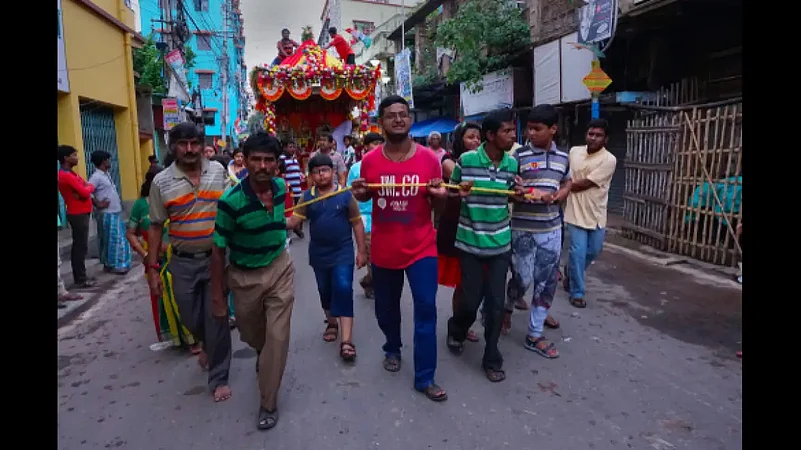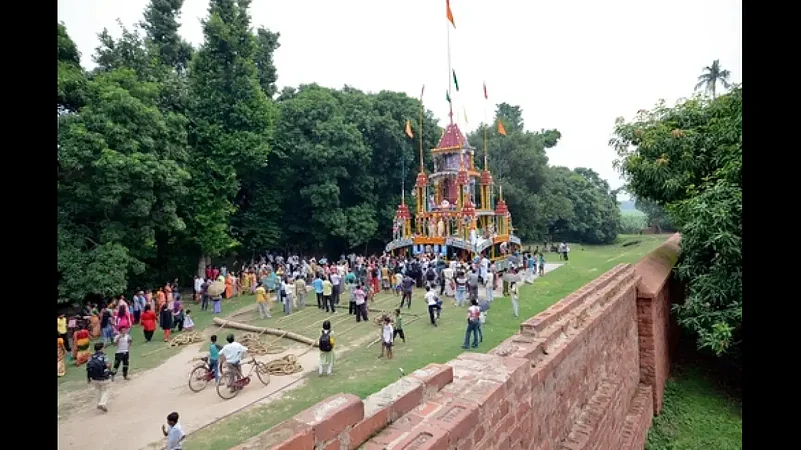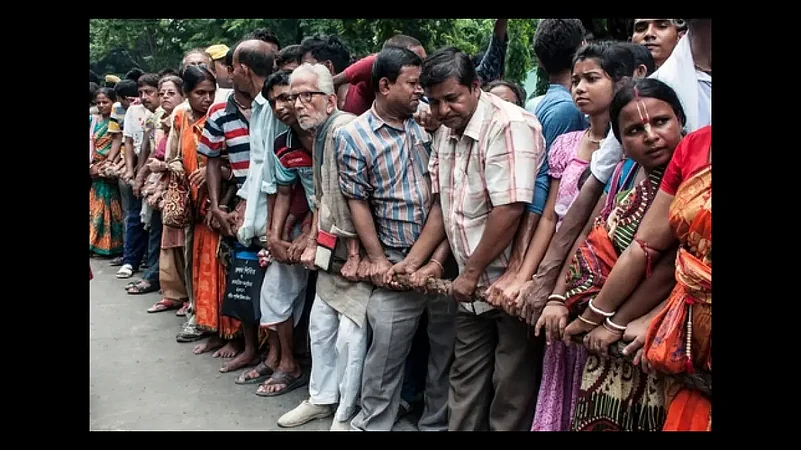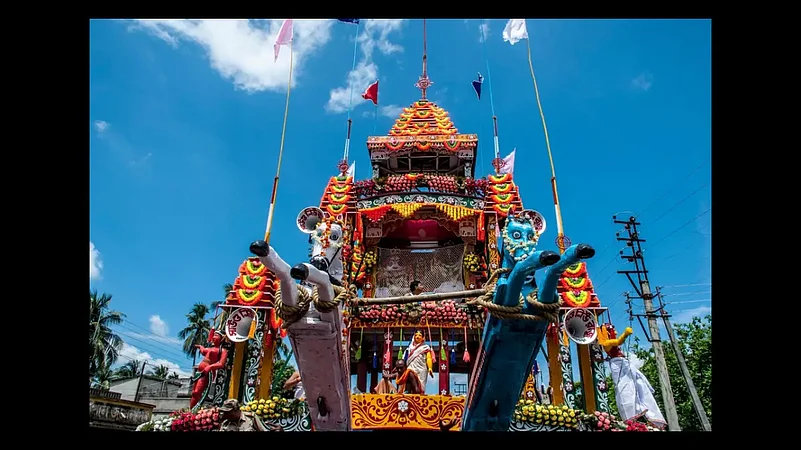With a strong Vaishanvite following, Bengal too has been celebrating the Jagannath Rathyatra festival for centuries. In Kolkata alone there are many households, temples and associations celebrating the chariot festival. Here are five famous chariot festivals within easy driving distance from Kolkata. Apart from enjoying the main festival, you may also visit the local fairs held simultaneously.
Mahesh
The Jagannath ratha yatra of Mahesh in Hooghly district, over 600 years old, is said to be the first of its kind in West Bengal. Being located in the heart of one of the most crowded areas of southern Bengal and being near to Kolkata, it draws a huge crowd. So it may be difficult to go near the chariot unless you are brave enough to push your way through a thick wall of people.
Advertisement
According to records, the chariot festival was introduced towards the end of the 14th century by Kamalakar Pipilai, a close associate of Sri Chaitanya Mahaprabhu, who was assigned the charge of looking after the idols of Jagannath, Balaram and Subhadra, carved at the behest of a devotee named Dhrubananda.
However, neither the original temple nor the chariot survived. The chariot was built and rebuilt several times. The one that we see today was built by Martin Burn Company in 1885, paid for by East India Company’s Diwan Krishnaram Basu. Made of iron, the four storey chariot is 45 feet tall. It is designed like a nine-spired (naba-ratna) temple. The idols are placed on the top tier. The chariot travels some distance to reside in a garden house to the north of Mahesh.
Advertisement
Information: By road, Mahesh is about 25km from Kolkata. Take a local train from Howrah to Serampore (Srirampur) station from where rickshaws are available or travel via GT Road by car to Mahesh. On the day of the ratha yatra, however, you have to park the car far from the venue and walk up. Usually the chariot starts rolling around 3pm. You may utilise the first half of the day to see the Danish and other colonial monuments of Serampore, concluding the morning trip with a lunch at the renovated Danish Tavern.

Guptipara
Guptipara in Hooghly district has been traditionally associated with Vaishnav culture. Even though the ratha yatra festival here draws a fair number of devotees, you may see the chariot being pulled in relative comfort.
Head for the Brindabanchandra Temple complex once you reach. The chariot is positioned next to it. The chariot festival was introduced in 1745. Initially, the chariot was much bigger with 13 spires. But after an accident in 1873, it was reduced to nine-spires. The chariot does not travel far as the temple denoting the ‘aunt’s house’ is at the end of the narrow road.

Advertisement
Information: Guptipara is about 90km from Kolkata via National Highway 6. You may also take a train from Howrah headed for Bandel-Katwa and get down at Guptipara station. There are rickshaws from the rail station to the venue. If you are travelling by car, note the roads leading to the temple are likely to be closed to traffic as early as 10am. But there are designated parking lots (ask the police personnel on duty) from where you have to walk down to the venue. The ratha yatra commences late in the afternoon, around 2 pm. Do not forget to visit the terracotta temple complex, especially the richly sculpted Ramchandra Temple. Guptipara is also known for its special Sandesh. You may try the shops at Barabazar not far from the ratha yatra venue. Note: Restaurant and washroom facilities are scarce.
Advertisement
Rajapur/Mayapur
The origins of the Jagannath Temple of Rajapur, a ubiquitous village not far from Bengal’s seat of Vaishnav culture and learning, Nabadwip in Nadia district, is buried in legends.
Apparently, the idols were carved nearly 500 years ago, after a local devotee received divine instructions. However, owing to lack of patronage and care, the temple was lost and gradually faded from people’s memory. According to some sources, the ruined temple was unearthed in the late 1950s by the owners of the plot. The idols were found almost intact and re-installed by the family in a new temple. However, when the family found it difficult to continue with the daily rituals and running of the temple, they handed it over to the International Society of Krishna Consciousness (ISKCON), whose headquarters are located in nearby Mayapur.
Advertisement
The chariots from Rajapur travel to the ISKCON headquarters in Mayapur, about 5km away by road, accompanied by a huge procession with devotees playing musical instruments, singing and dancing to hymns. The Gundicha Temple, where the idols reside for the next seven days, is located near the Prabhupada Ghat on the Ganga River. Religious discourses and cultural programmes are held during the festival.
Information: From Kolkata, you may travel directly by road to Rajapur, less than 150km away. Takes around five to six hours, depending on the road and traffic conditions. Or, you may travel to Krishnanagar by train and avail local transport or rent a private car to travel to Rajapur, 15km away. Or you may wait in Mayapur (about 135km by road from Kolkata and 20km from Krishnanagar). Usually, the procession from Rajapur starts at 2.30pm. You may spend the night at ISKCON’s guest houses in Mayapur or in private hotels in Krishnanagar. When there, do not forget to savour the special sweet curd (misti doi) of Nabadwip or the sweets (sorpuriya and shorbhaja) of Krishnanagar.
Advertisement
Amadpur
Little known beyond the town’s periphery, the ratha yatra at Amadpur is still patronised by the former ‘zamindar’ (landlord) family, the Chaudhuri-s and sees enthusiastic participation from the local households. Little remains of the original chariot, as it has been overhauled through the years. However, here the family’s guardian deity, Radhamadhav and his consort, who ride the chariot. The idols reside in a small, centuries old terracotta temple. On the day of the festival, they are carried to the chariot by the priests and family members. Prior to that, they are taken to the Durga Bari (where the annual Durga Puja is held) for some rituals.
Advertisement
Far from the frenzied activities seen at most of the other festivals, ratha yatra at Amadpur has a pastoral note to it. According to local customs, mud from the chariot’s wheels are taken for a token smearing of the wooden framework on which the Durga idol will be cast subsequently.
Information: Amadpur, about 100km away from Kolkata by road via Memari, can be reached by road and by train. From Howrah station, you can take a Burdwan-bound local train and get down at Memari station, which is about 10 minutes’ drive away from the Chaudhuri house. Or, you can drive down straight from Kolkata. You may also stop for lunch here but you have to inform well in advance.
Advertisement
Mahishadal
Still patronised by the former royal family (the Garg-s) of Mahishadal, a town in Purba Medinipur district, the ratha yatra draws a huge crowd. It is said that Rani Janaki Devi introduced the chariot festival in 1776. The five-storied chariot was 75 feet in height and had 17 spires. The present chariot has been built anew.
Following the old customs, a member of the Garg family (the king to the local people even though the title has been abolished) arrives in a palanquin with much fanfare. It is he who tugs at the rope first signalling the start of the journey.
Advertisement
Information: Mahishadal is around 100km by road from Kolkata via Kolaghat. You may travel by train from Howrah to Haldia and then onwards by road. However, driving down from Kolkata is a more comfortable option. Usually, the ratha yatra begins around 2.30pm.

Note: Pulling the chariots is considered a highly merit-making service by devotees. Hence there is a great rush when the chariots begin to roll. Best to stand well back from the path of the chariot and the crowd. Best to consult the local people about the route and the vantage point to see the chariots roll by.
Advertisement
Since it is the time of the monsoon, be prepared for showers and humid weather. Carry drinking water, umbrellas, light snacks.
Check with the local police personnel on duty about car parking areas; usually owing to the crowd, the designated parking areas are at a distance from the main venue, and may require you to walk down to the venue.




















